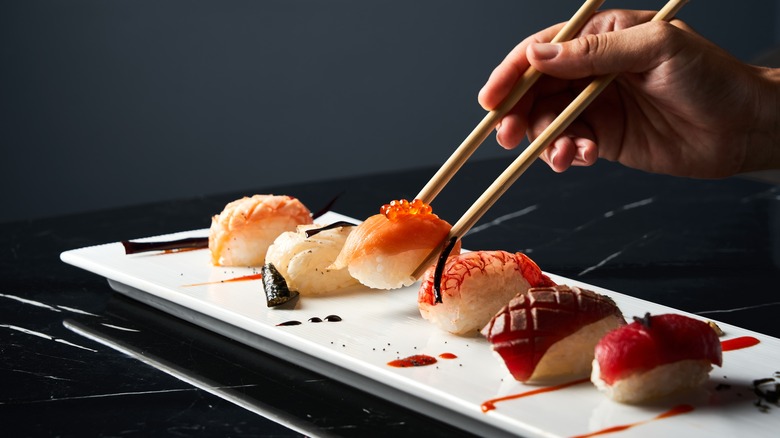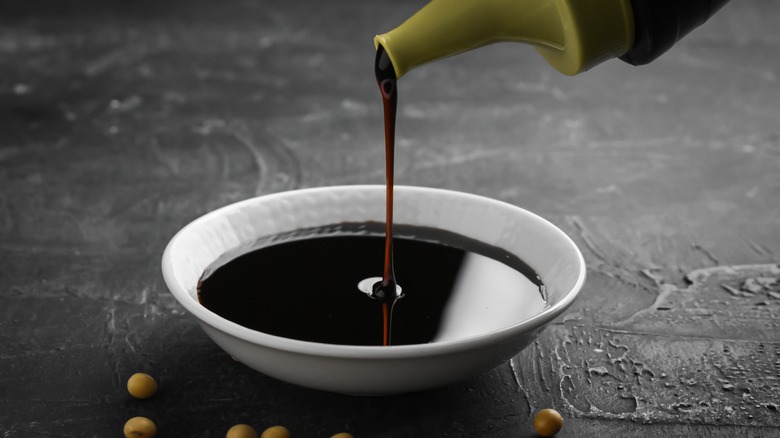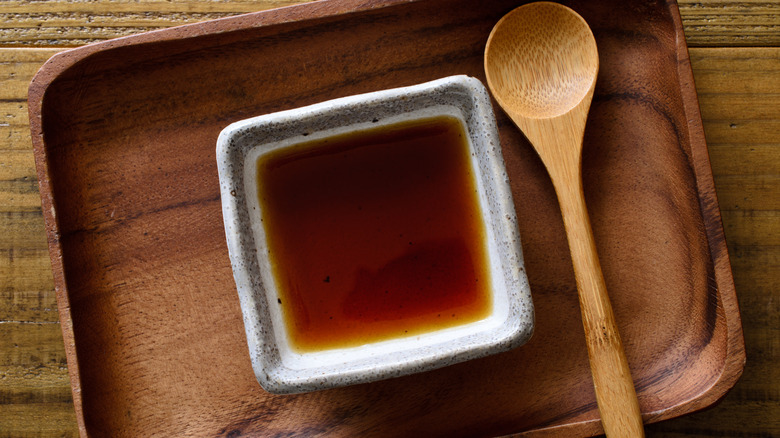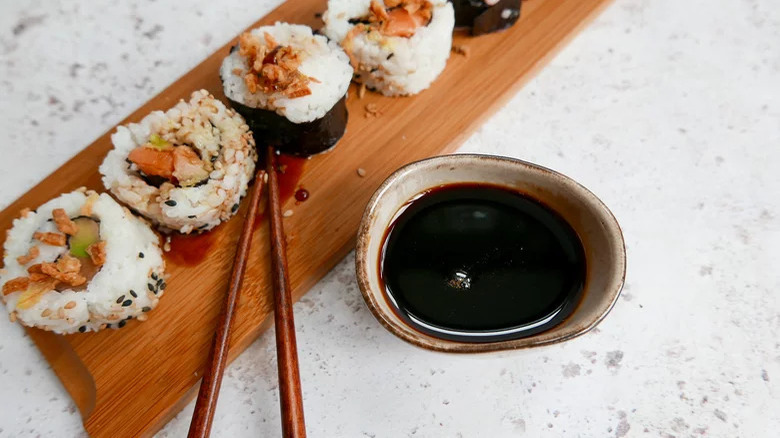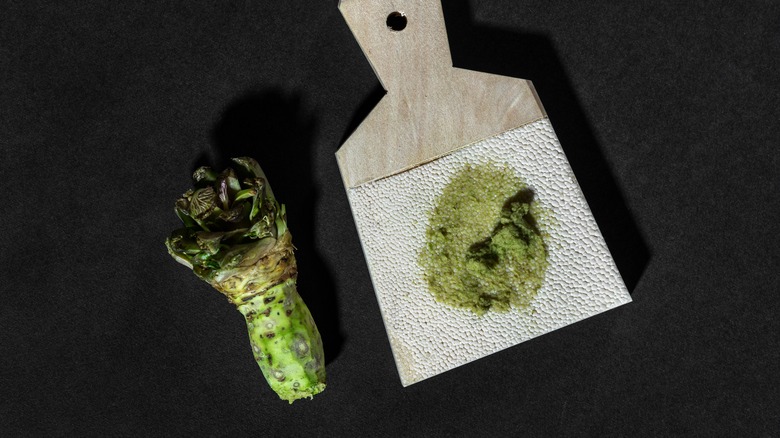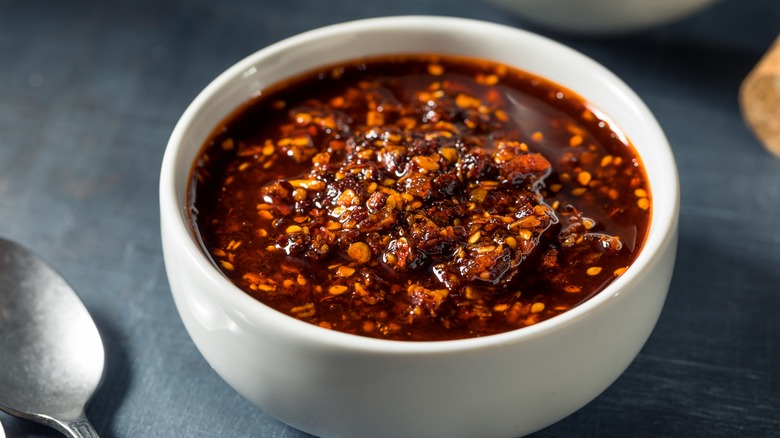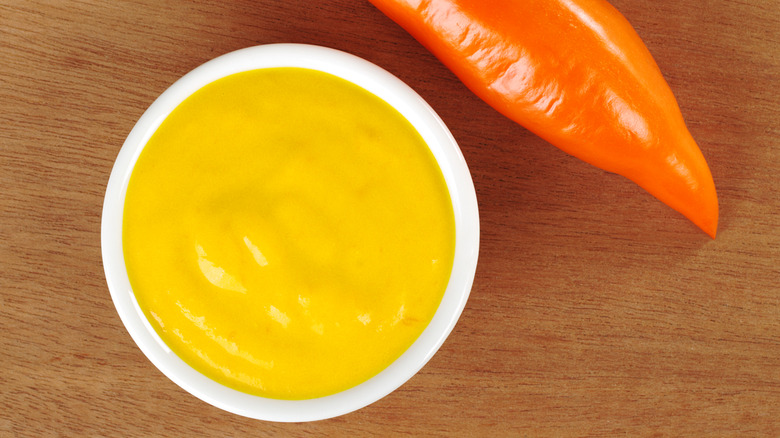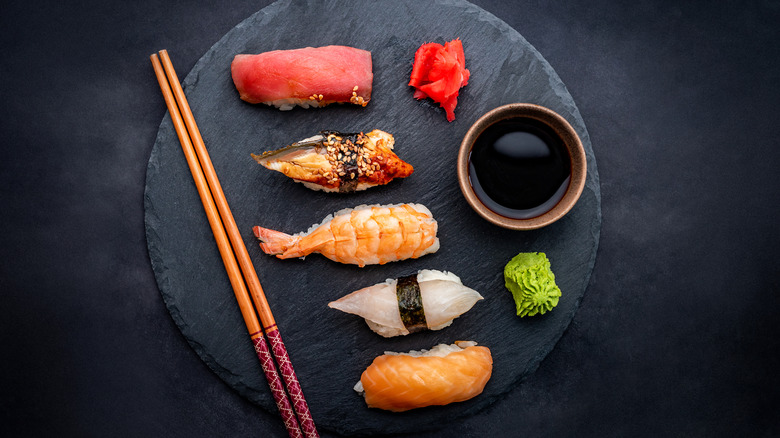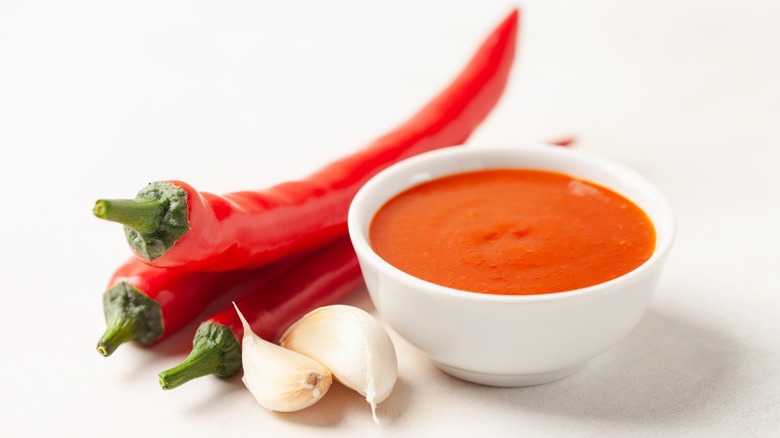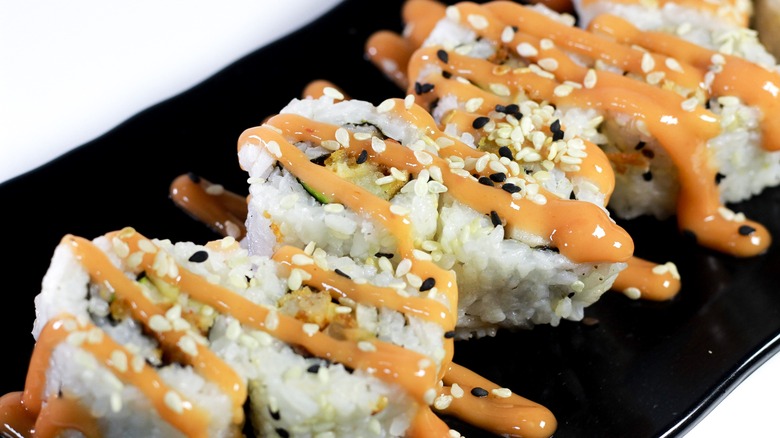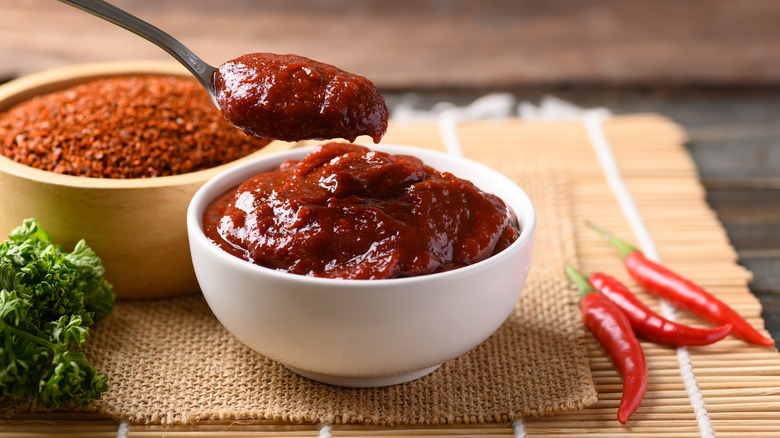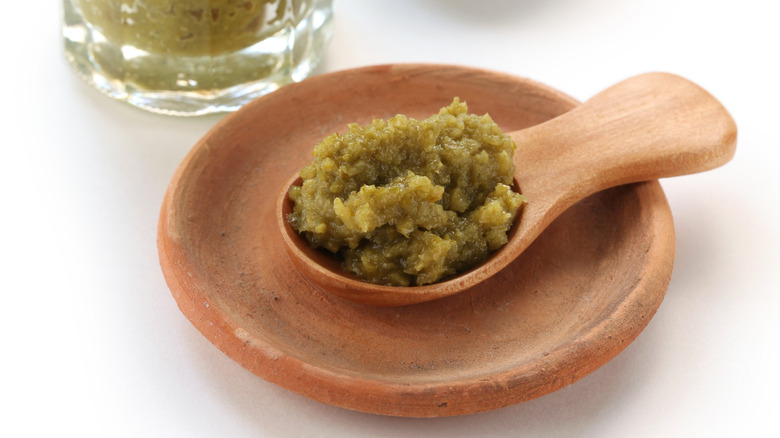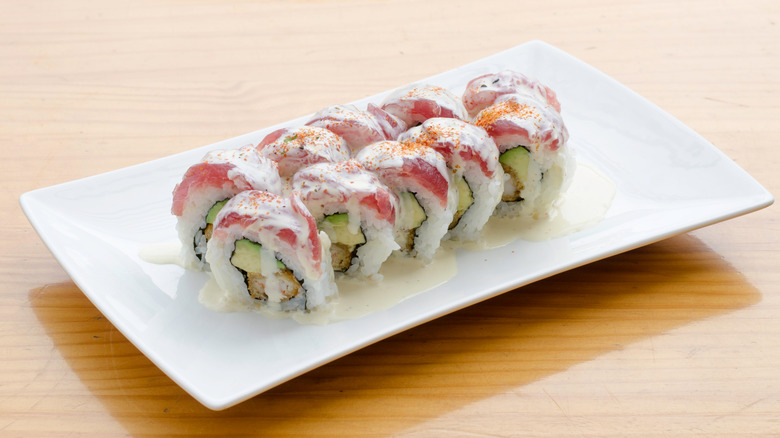12 Types Of Dipping Sauces For Sushi
Finely crafted sushi is nothing short of a masterpiece — a delightful fusion of flavors and textures to tantalize the tastebuds. But, the secret sauce (quite literally) between your plate and your eager tastebuds can elevate your sushi experience to unprecedented heights.
Whether you dip, drizzle, or dunk, a sauce can bring out the best in your sushi. At times rebellious, a tangy sauce like ponzu can gracefully disrupt the flavor balance in exciting ways with contrasting, sour tones. Or, something with mineral depth, such as white soy sauce, can partner with fish for a harmonious duet that doubles down on the traditional characteristics of sushi. And don't forget mouthfeel. Something such as chili crisp can play with the texture, introducing a bit of crunchiness that transmutes each bite to a new sensation.
A note before we dive in: If you're trying high-end omakase dining where the chef's skills guide your meal, asking for extra soy sauce might not be the norm. But for those delightful sushi-making experiments at home or when you're enjoying take-out, you're in for a treat. These salty, sweet, spicy, and savory accompaniments can easily turn your regular sushi night into something gourmet-worthy.
1. Soy sauce
While many types of soy sauce can infuse complexity and subtlety into your favorite dishes, a few will make your sushi sing. First is shoyu, the classic Japanese soy sauce. Gracing sushi spots and local markets alike, this blend of fermented soy and wheat creates a symphony of tastes — balancing saltiness and umami, as well as subtle notes of fruit, vanilla, and even whisky — that make it a seamless partner to the slightly sweet and gently vinegared rice that defines sushi.
For a lighter, sweeter touch, try shiro, a white soy sauce. Its higher wheat content lends it a warm amber hue and a graceful flavor profile, elegantly enhancing delicate flavors without overpowering. Shiro shines in high-end cuisine, complimenting intricate dishes with finesse without stealing the spotlight.
Looking to keep it gluten-free? Have tamari. Although it has a higher soybean content, tamari is a decadent and lower sodium alternative to shoyu. Tamari's profound character expertly enhances umami notes, showing out as a robust companion where it's used. Check the label of your particular brand, though, as some can contain trace amounts of wheat.
Moderation with soy sauce is key. Drenching your rice can lead to sushi mishaps. Instead, the right way to eat nigiri is to opt for a gentle dip and place the fish or seaweed side down. That perfect burst of flavor will ensure the fish stands out.
2. Ponzu sauce
Ponzu sauce, the zesty soy vinaigrette, offers a hint of sweetness and a burst of citrusy delight to everything it touches. This versatile and exciting concoction (no wonder its name means "vinegar punch") can be used as a condiment, marinade, or salad dressing. Dating back to the 17th century, ponzu was traditionally crafted by simmering mirin or rice wine, rice vinegar, bonito flakes, and seaweed, then adding a zing of citrus, often yuzu or sudachi. Modern iterations skillfully blend this mixture with soy sauce, resulting in a surprising symphony of bright, vibrant flavors with rich umami undertones.
Try it with lean white fish like flounder, halibut, or sea bass to keep things light. Or let it brighten up fattier fish like salmon and toro (tuna belly). While there are some great brands in your local market, a ponzu sauce recipe is also surprisingly easy to whip up at home, where you can substitute lemon and lime juice for the harder-to-find Japanese citrus fruits.
3. Unagi sauce
If your tastebuds dance for fries dipped in barbecue sauce, unagi sauce could be your sushi soulmate. Named after the Japanese term for freshwater eel and referred to as eel sauce, nitsume, kabayaki sauce, or sometimes just sushi sauce, unagi sauce presents an enchanting fusion of sweet and savory notes. It is born from the marriage of soy, sake, mirin, and sugar. When diving into heartier sushi selections featuring eel, rolls incorporating tempura, or simply craving a mixture of sweet and salty, reach for the unagi sauce.
Eel sauce also has a versatility that shines in everyday cooking since it can improve a broad spectrum of dishes. Try it on grilled meats, veggies, or even as an ice cream topping. Though you'll be able to find unagi sauce at markets and specialty stores, a delicious eel sauce recipe is simple to try at home. For the unfamiliar, unagi sauce boasts a luxurious thickness that acts like a glaze. To relish its magic, start with a small amount, opting for a delicate drizzle rather than a hearty dunk.
4. Wasabi
Looking to spice up your sushi escapade? Welcome to the world of wasabi. Belonging to the same family as horseradish and mustard (often stand-ins in modern sushi joints), wasabi is a rhizome with an intriguing history rooted in Japan, where its first uses were as traditional medicine. This prized ingredient has garnered a reputation for being a tough nut to crack in cultivation, adding to its allure and rarity. Wasabi can be turned into a sauce easily, but it is also good in a paste form.
Both "true" wasabi and its Western counterpart pack a distinctive, brief burst of intense heat, followed by a delightful tingle. It's a sensation you'll encounter in many sushi creations. While enjoying wasabi with sushi, a little goes a long way. Try adding just a touch to your roll or mix up some wasabi powder with a touch of mayo for easier dipping if you're at home. Just remember to avoid mixing wasabi with your soy sauce; it is proper etiquette to dab each item individually rather than making a blend.
5. Chili crisp
We are absolute enthusiasts of chile crisp and its Mexican counterpart, salsa macha. Clearly, we're not alone. It's seemingly everywhere right now, and frankly, it's hard to find something these piquant and intricately textured condiments don't complement. Both concoctions result from infusing oil with aromatic ingredients, including crunchy dried chile peppers, onion, and garlic. The heat levels can stretch from a playful zing to an outright mouth inferno. Yet, the fusion of texture and fragrance, combined with that zippy warmth, truly steals the spotlight and engages every one of your senses. We've tried this on everything from hand rolls to tamago and haven't gone wrong yet.
There are quite a few brands of chili crisp (sometimes called chili crunch) out there for you to try and find your favorite. While the OG Lao Gan Ma offers an excellent starting point, don't miss out on other varieties from culinary pioneers like Momofuku, Fly by Jing chili sauce, and even Trader Joe's. Like all things fiery, start with a conservative approach; opt for a small spoonful over the top (and don't forget the crunchy bits).
6. Aji amarillo
Simply meaning "yellow chili pepper" in Spanish, this bright pepper bursts with a vibrant, fruity profile and a kick of heat, ranking around 30,000 to 50,000 units on the Scoville scale. Beyond its flavor prowess, aji amarillo is a Peruvian pepper that shows its diversity by playing a key role in much of the country's food traditions.
One focus area of aji amarillo is its role in Nikkei cuisine, a harmonious fusion of Peruvian elements and age-old Japanese techniques dating back to the early 1900s when Japanese immigrants settled in Peru. For dishes like tiradito, a citrusy ceviche-style take on sashimi, the pepper is typically transformed into a luscious, creamy sauce, utilizing mayonnaise and crema fresca, along with tangy lime juice as well as onions, garlic, and other seasonings. You'll find it on menus at high-end sushi restaurants everywhere, from trend-setting stalwarts such as Nobu to exciting up-and-comers such as Los Angeles Michelin Guide-recommended Sushi Nikkei.
With just a drizzle on your favorite nigiri — especially stunning in tuna and octopus — this delightful concoction will add an irresistible warmth and a creamy tang to your favorite sushi indulgence. Elevating the game with its zesty flair, aji amarillo isn't just a condiment; it's a flavor-packed journey awaiting your taste buds.
7. Ishiru
The uniqueness and delightful funk of fish sauce, while not for the faint of heart, has woven its way through cuisine and culture since ancient Greece. In Japan, a distinctive twist on this flavor-packed condiment emerges from the Noto Peninsula, nestled within Ishikawa Prefecture. Enter Ishiru, which may deserve a category all its own. Unlike the majority of fish sauces around the world, ishiru isn't made from fish at all, but rather from the livers of the Japanese common squid, also known as the Pacific flying squid.
In contrast to most South Asian brands, Japanese versions of fish sauce tend to maintain a delicate profile, offering exceptional versatility. Ishiru is no exception, making it not only an excellent addition to soups and stews but also a viable alternative to soy sauce in many sushi applications. If you're unfamiliar with its flavor profile, you may want to start with a small amount to savor the distinctive character of ishiru without overpowering your sushi.
Still unsure? Try mixing up a blend of half ishiru and half shoyu in your mame-zara (sauce dish). Just a few drops of this concoction can transform a handroll or simple maki, like tuna or cucumber rolls, and infuse it with a salty and savory depth.
8. Sriracha
If you're like us, you've tried this fiery chili sauce on everything from pizza to fried chicken. While most of us are familiar with LA-based Huy Fong's rooster adorned label, the original sriracha sauce was created 80 years ago in the town of Si Racha, on the Gulf of Thailand, and was originally intended as an accouterment for fresh seafood. In the years since this iconic sauce's versatile and bold flavor has secured it a beloved place in kitchens and on menus worldwide. Is there any wonder that sriracha deserves a spot in your sushi repertoire as well?
Sriracha is more than just a one-trick pony; it combines garlic for depth, sugar for sweetness, vinegar for tanginess, and a touch of salt, creating a captivating and multifaceted taste sensation. As such, you may want to skip this sauce when enjoying nigiri or other more delicate creations, as its bold flavor may overpower them. However, its signature heat, derived from red chili peppers, pairs wonderfully with heartier sushi options like unagi or deep-fried rolls and definitely deserves a place in your chirashi bowl.
9. Spicy mayo
A dollop of spicy mayo is an easy way to add that extra dimension to all things sushi. In fact, some version of this versatile sauce is probably already a key ingredient in some of your beloved multi-layered maki rolls, not to mention its appearances in your favorite sandwiches, fish tacos, poke bowls, etc. Whether going by the name spicy mayo, sriracha mayo or dressing, or bearing a title with the word "dynamite", this simple but exciting condiment offers up heat, tang, and creaminess and can elevate sushi of all sorts. Try a drizzle over your ebi nigiri or dip in to add a bit more spicy to your spicy tuna roll.
There are dozens of brands available at supermarkets and specialty stores as well, and you can even request an extra side with your take-out, but making your own is one of the simplest ways to elevate the flavor of mayonnaise. Get your spicy stuff, be it sriracha, hot sauce, or your favorite chili paste, and mix it up with mayo. For a richer flavor and an oh-so-velvety texture, we love using Kewpie, but Hellman's works great as well. Want to make it a bit brighter? Add a squeeze of citrus. That's it! You've just introduced a creamy and exhilarating element to your sushi.
10. Gochujang
If you've tried bibimbap or bulgogi, you may be familiar with the smoky-sweet chili paste called gochujang with a long history in Korea. Gochujang often serves as a versatile ingredient and condiment, adding heat and sweet-savory notes to Korean staples as well as various soups and noodle dishes. Perhaps less commonly known is that gochujang also frequently steps in as a wasabi substitute when relishing hwe, a Korean dish with similarities to sashimi, in which fish is plucked live from tanks just moments before serving. It equally finds its place beside kimbap, another staple in Korean cuisine with a similar construction to Japanese maki rolls, making the respective origins a subject of longstanding culinary debate.
For the uninitiated, gochujang is somewhat comparable to sriracha, albeit with a stronger flavor and deeper umami notes owing to the fermentation process it undergoes. What's noteworthy is gochujang's adaptability—it comes in various spice levels, and in fact has its own scale, ranging from mild to extreme hot. So, even if spicy foods aren't necessarily your go-to, there's room to explore. You can find traditional brands in Korean markets. Sweetened versions are also frequently found in Western grocery stores, sometimes labeled as Korean chili sauce. Consider drizzling this flavorful sauce over your salmon roll or chirashi for a dash of the unexpected.
11. Yuzu kosho
This incredibly versatile chili paste originally hails from the Japanese island of Kyushu, where it masterfully combines the fiery heat of Thai chili peppers with the vibrant essence of both the juice and zest of yuzu citrus. The result is a truly exquisite flavor profile that can elevate almost any dish.
Yuzu kosho offers two enticing varieties: green and red. The green version, created with green chili peppers, provides a milder heat paired with a delightful herbal freshness. In contrast, the red yuzu kosho featuring red chili peppers, packs a bit more punch and delivers a bolder, smokier flavor.
In its pure paste form, yuzu kosho serves as a brilliant wasabi substitute that's salty, spicy, and refreshing, making it the perfect finishing touch for nigiri, particularly the torched varieties. To unlock its full versatility, however, consider mixing it. You can start by blending a small amount with your soy sauce for an instant dip that seamlessly balances saltiness, umami, and zesty spice. Perhaps unsurprisingly, yuzu kosho also forms delightful partnerships with creamier ingredients like avocado or mayonnaise, so try blending some of these together to craft a tantalizing creamy-spicy interplay. Whether drizzled over nigiri or simple maki, it infuses a burst of flavor that will leave you craving more.
12. Acevichado sauce
Acevichado sauce, the brainchild of the culinary maverick Nobu Matsuhisa, is like a tasty lovechild of Peruvian and Japanese flavors. It burst onto the scene in 1973 alongside Matsuhisa's groundbreaking creation the maki acevichado (ceviche roll) at his pioneering restaurant Matsuei, Peru's inaugural sushi bar. In the years since, maki acevichado has found itself on Nikkei menus everywhere, and the sauce that bears its name has found its place as a brilliant way to enhance sushi of all sorts.
Acevichado sauce is a wild blend of zest and heat. Think tangy citrus, mostly from zesty limes or lemons, starting you off with a zing. Chili peppers follow up with just the right amount of sizzle, but it's the balancing ingredients, including garlic, ginger, cilantro, and even a subtle umami kick from fish stock, that really up the intrigue here.
It's versatile, too. The bright citrus accentuates the innate flavors of white fish, such as flounder and snapper, while its touch of spice provides an electrifying contrast to rolls featuring spicy tuna or yellowtail. Acevichado sauce can be found in specialty markets and online. Or, the next time you make ceviche, try mixing some mayonnaise in with the remaining citrusy juice to create your own version of this South American sensation.
